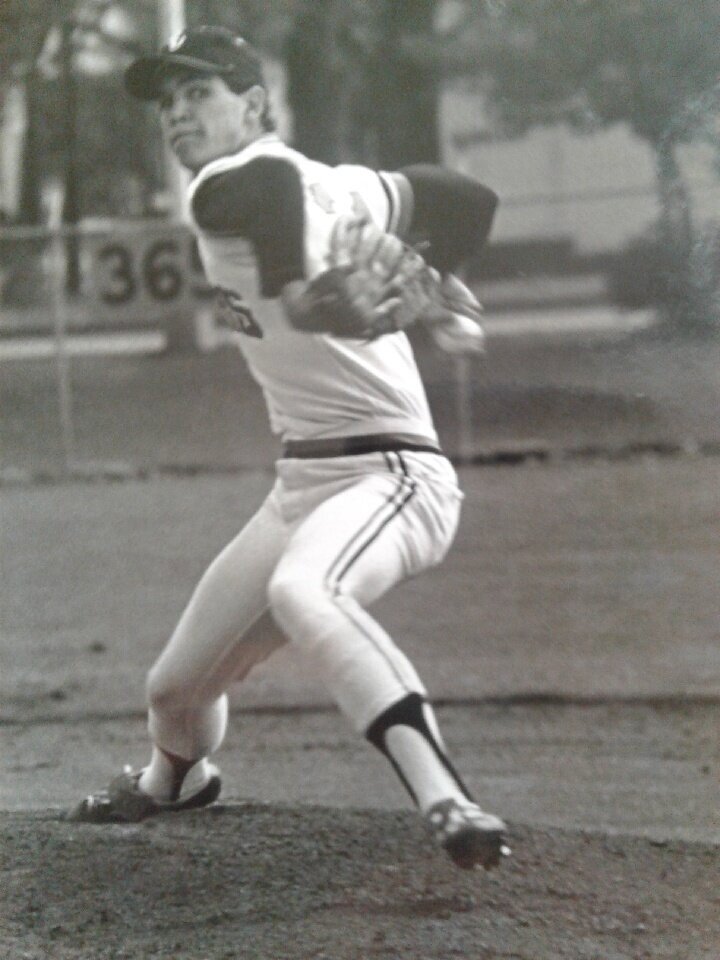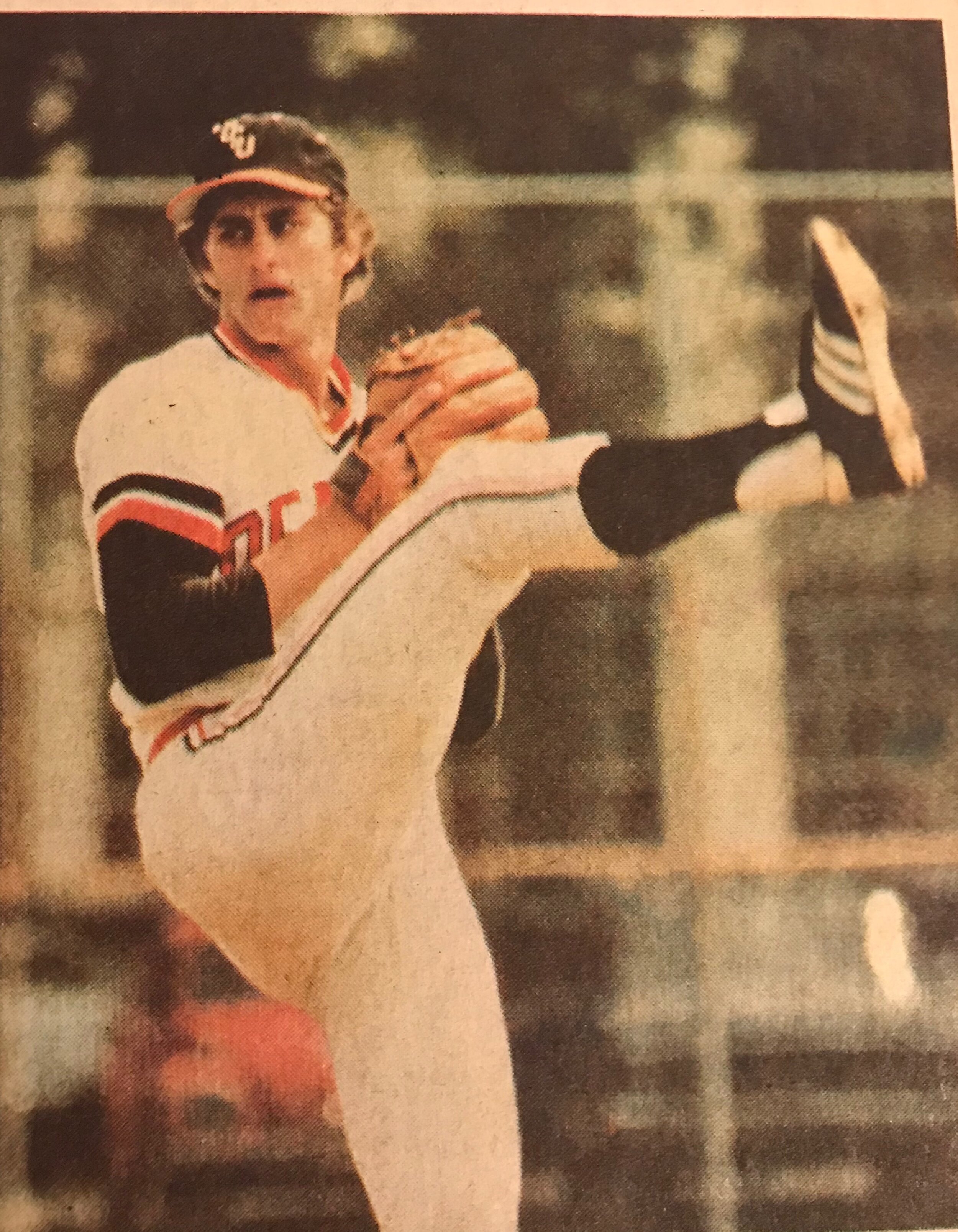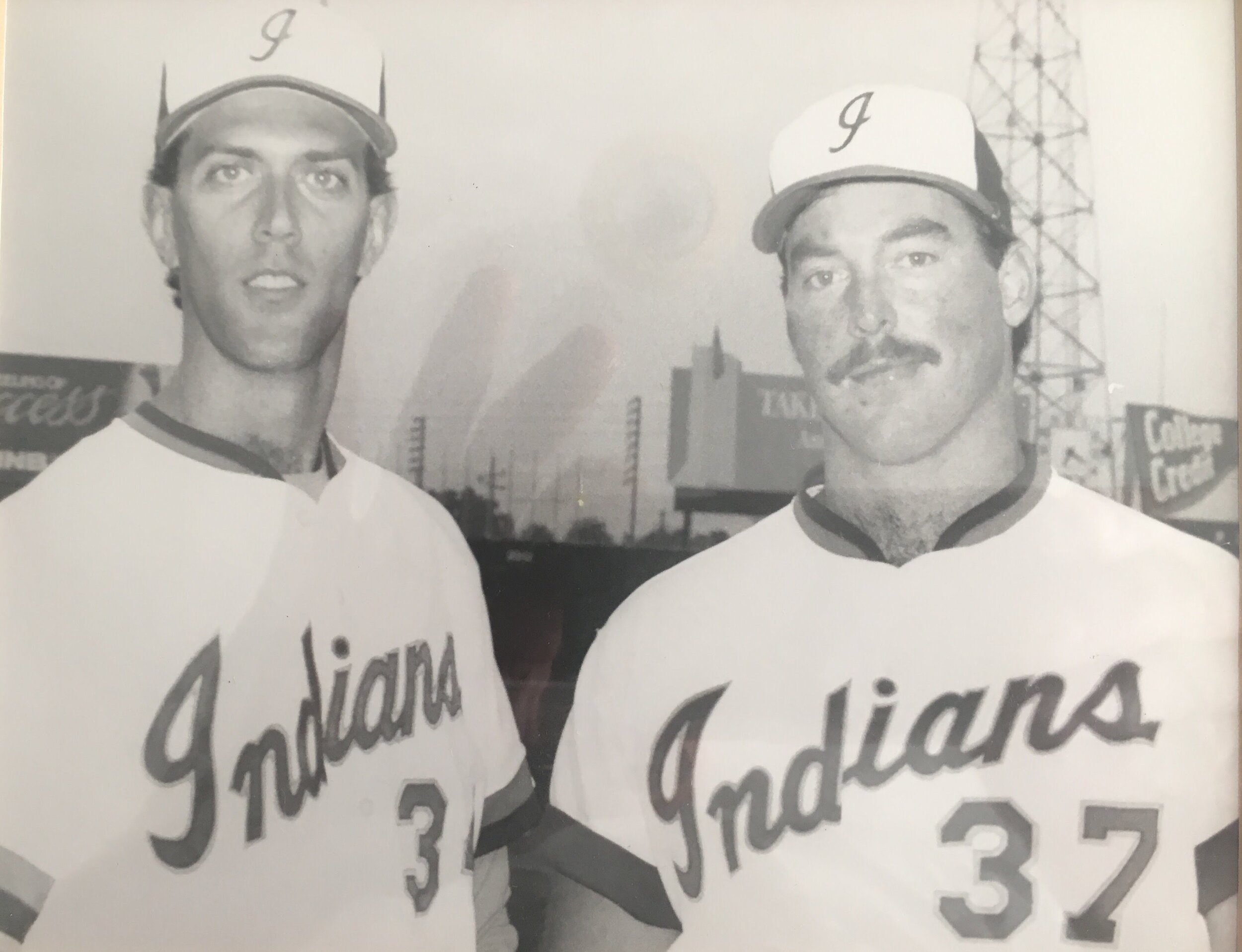How would Beaver teams of the early ’80s and ’19-20 compare? There’s really no comparison
Editor’s note:
Special contributor Jim “The Whale” Wilson is being modest when he indicates he “played” on Oregon State’s football and baseball teams in 1981.
As a junior in 1981, the long-time radio analyst of Beaver football and baseball was a starting offensive guard for Joe Avezzano. The 6-3, 245-pound Wilson was ticketed to be OSU’s starting center as a senior in 1982 before opting to sign a pro baseball contract in June after his junior season.
Jim Wilson, Kerry Eggers (working for the Oregon Journal), Mickey Riley, and Ken Goe at the OSU-Stanford PAC-10 playoff game in 1982
It was in baseball where Wilson really made his mark, cracking 21 home runs, a school single-season record that stands today. Jack Riley’s ’82 team went 29-15 and won the Northern Division championship, advancing to a post-season showdown with Southern Division runner-up Stanford at Sunken Diamond. The Beavers lost 15-6 and 15-4 to the powerful Cardinal, but Wilson swatted a pair of circuit clouts in the two games.
Jim Wilson
I believe Wilson would have had a hard time finding a position in the current Oregon State football program without some serious size and strength gain, but could have been an effective and powerful bat in the middle of the Beaver baseball lineup.
Here, Wilson offers his appraisal of how current OSU teams would fare against teams of his era.
JIm Wilson
By Jim Wilson
Has anybody seen the website WhatIfSports.com? It is an interactive site that allows users to select sports teams from different eras and pit them against each other in a computer simulated game. It is an intriguing concept -- having players and teams from different eras compete as if they were in their respective primes.
I’m not sure how a computer decides whether Dr. J can rise over Giannis Antetokounmpo, but it certainly sparks debate.
When I was growing up, I thought it was preposterous for an ex-athlete to think or say that the brand of play in their generation was better than now. Everybody knows that athletes keep getting bigger, faster and stronger.
George Mikan, for all his greatness, would probably struggle to play college basketball in today’s world. Mikan played in the 1940s and was way ahead of his time at 6-10 and 245 pounds. He was inducted into the Basketball Hall of Fame in 1959 and was elected one of the NBA’s 50 Greatest Players in 1996. He would be astounded with the speed and strength of today's players.
Do you think that Babe Ruth could swing his 46-ounce bat against modern day pitchers? Ruth was a big man in his time at 6-2 and 215 pounds -- now he is basically the same size as the average major league player (6-1 1/2 and 211 pounds).
Everybody agrees that the athletes are getting bigger and stronger. But competition is so much more than that. There are emotional and mental components that usually go a lot further in determining an athlete’s success than physical prowess.
I would argue that modern-day athletes do not have an advantage in those intangible areas.
Particularly in baseball, where players rely more on their skill set — throwing, catching, hitting — and less on sheer physical size and strength. I can't imagine a scenario where a football team from 1981 could hold up against a team from today. But baseball at least allows the opportunity to compete.
Good athletes in all eras make adjustments and figure out how to get the job done. Maybe Ruth would just need a spring training to get acclimated to the current game.
Of course, we’ll never know.
Since I played football and baseball on the 1981 teams and am currently the radio analyst for the 2019 squads, I have a unique perspective on the respective time periods. Here is what I think would happen if the 1981 and 2019 Oregon State teams met on their respective playing surfaces.
Football:
Athletes continue to get bigger, faster and stronger, and in no sport does that play a bigger role than football. In a full-contact sport like football — bigger is better if it is also faster — and that’s the case in this comparison.
Forget NFL draftees Jake Luton, Isaiah Hodgins and Blake Brandel or free agent signees Clay Cordasco, Noah Togiai and Artavis Pierce. The ’19 version of Beaver football could mop the floor with the 1981 team without using a single starting player.
This comparison doesn’t provoke much thought on whether athletes from a previous era could play in today's game as the '81 squad had enough trouble playing back then. The gap in talent between the two teams is as obvious as the difference between the new and improved Reser Stadium and the old Parker Stadium.
The first year of the Joe Avezzano era was 1980. Upon his arrival, Avezzano ratcheted up the off-season workouts and conditioning program to the point where players transferred out at a record clip; no fewer than 12 scholarship players departed from the 1-10 team Avezzano inherited.
It took Avezzano five years to build the program back up to not very good again.
Even a winless team has some quality players, and that was the case for the ’81 Beaver football team. Two of my mates on the offensive line, a tight end (Chris Smith) and a wide receiver (Victor Simmons) were exceptional football players with the size, strength and speed to play in any era. Center Roger Levasa, in particular, was the best center prospect on the West Coast and would have been a sure-fire NFL guy had it not been for a serious knee injury. Smith, Simmons and guard Kevin Donaghue were other offensive players that stood above the rest.
There were others for sure, but the current program has 85 scholarship players and a handful of walk-ons who are legitimate Division I football players. The current Beaver football program is trending upwards and the facilities have been upgraded across the board.
That was not the case in 1981.
Basketball:
The ’80-81 Beavers were coached by the legendary Ralph Miller, whose trademark pressure defense helped him win 359 games in 19 seasons at OSU and 657 wins in his storied career. He was inducted into the Naismith Memorial Basketball Hall of Fame in 1988.
Steve Johnson
The 1981 team also had great players. Steve Johnson was the catalyst. The 6-10 center led the country in field goal percentage and was the seventh player selected in the NBA draft. Guards Ray Blume and Mark Radford were both long-armed 6-4 guards who defended the entire court, passed and scored. The other starters were forward Charlie Sitton and swing man Lester Conner, two of the great names in Beaver basketball lore.
Steve Johnson, Mark Radford, and Charlie Sitton
Great coach, great players, great team, this 1981 squad is a ringer in a conversation like this because it was that good.
Last year’s basketball squad finished 18-13 under sixth-year head coach Wayne Tinkle. The Beavers won their Pac-12 Tournament opener over Utah before the season was curtailed due to the coronavirus pandemic. The ’19 team was led by seniors Tres Tinkle and Kylor Kelley and junior Ethan Thompson. During the season, Tres broke the Oregon State career scoring record set 30 years ago by Gary Payton while Kelley is the top shot blocker in Beaver history.
Envisioning Johnson and Kelley battling in the middle is intriguing. Kelley is taller than Johnson and is a dynamic leaper while Johnson was surprisingly quick for his size and had a baby-hook that was nearly unstoppable. Equally entertaining is the thought of Tres Tinkle navigating the perimeter defensive prowess of Blume, Radford and Conner.
The two teams are about the same in terms of size and the current team may actually have better athletes, but the skill level of the '81 team was far superior. The '81 squad could shoot, pass and defend, won three consecutive Pac-10 titles and spent eight weeks as the No. 1 ranked team in the country.
I believe the '81 squad would be the best team on the court, which, by the way, is named Ralph Miller Court. To take matters one step further, I think Miller's well-oiled machine would win the present-day Pac-12 Conference.
The Beavers were that good.
As a side note, one of the best basketball teams I have ever seen play in Gill Coliseum was the ’80-81 Arizona State team. The Sun Devils’ starting lineup included backcourt stars Byron Scott and Lafayette ‘Fat’ Lever, who both went on to long and prosperous NBA careers. The front line featured dominant 7-footer Alton Lister and 'Slammin' Sam Williams. ASU beat the then 26-0 and top-ranked Beavers 87-67 at Gill in the regular-season finale that season.
Baseball:
The biggest difference in the respective eras is the evolution of college baseball from a conference and national standpoint.
In 1981, football and basketball were as big to fans across the country as they are today. College baseball had not yet taken hold like it has in the last few decades and from a conference level the Beavers did not even compete in the Pac-12.
Oregon State had winning teams year in and year out under Jack Riley, but they played in the NorPac, a hybrid conference combining Pac-10 schools OSU, Washington State and Washington (no Duck baseball at the time) with Gonzaga, Portland, Portland State and Eastern Washington.
The current Beaver teams play in the baseball-rich Pac-12 Conference in a full-fledged round-robin schedule. Of course, the baseball program itself has stepped into rarified air with three national championships and five College World Series appearances in the last 15 years. Those are things folks from my era didn't even dream about.
About the only similarity between the two eras is the location of home plate and the name of the field. The '81 team played AT Coleman Field while the current Beavers play ON Coleman Field at Goss Stadium. The upgrades to the new stadium and the atmosphere at Goss have been catalysts to the program's status as a national contender.
This is an easy call as Mitch Canham’s 2020 Beavers are superior to their 1981 counterparts. The quality and quantity of arms on the current team's pitching staff is the most recognizable difference in the two teams as last year’s pitching staff had no fewer than 10 quality pitchers: Bryce Fehmel, Brandon Eisert, Grant Gambrell, Mitchell Verburg, Christian Chamberlain, Jake Mulholland, Sam Tweedt, Dylan Pearce, Joey Mundt, Nathan Burns and Jake Pfennigs.



In '81, the top pitcher was junior Mike Gorman (drafted by Oakland in the 21st round), followed by freshmen Scott Anderson (Texas, seventh round) and Jeff Reece (Milwaukee, third round). Anderson would go on to pitch in the major leagues and Reece was an incredible athlete who was the league's MVP as a junior, but that just doesn't stack up against the pitching quality and depth of the 2019 team.
In terms of position players, '81 first baseman Bob McNair and third baseman Alan Hunsinger would likely start for the current team because of their bats. Both were legitimate home run hitters who played their respective positions very well. Center fielder Steve Lyons had an uneven college career, but it is hard to discount a guy who went on to play 10 years in the major leagues. And lastly, shortstop Todd “Tiny” Thomas was a leadoff hitter with speed and all the intangibles. Thomas played centerfield and shortstop in his Beaver career and was above average at both positions.
Readers: what are your thoughts about the early 80’s Beavers teams and the teams from this past season? Who are your favorite all time Beavers players? Share them in the comments below.
Reach out to Kerry Eggers here.
Be sure to sign up for my emails. Every email subscriber on August 31 will be entered for a drawing to win a signed copy of the book Bill Schonely and I wrote, Wherever You May Be…The Bill Schonely Story, available in bookstores everywhere.